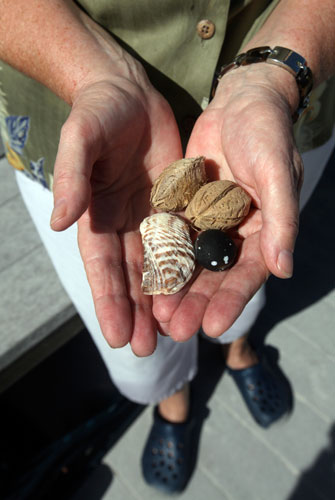
INDIAN RIVER COUNTY — Margaret Goembel had just taken part of her early morning beach walk from the Disney Resort to John’s Island and was on her way back north, when she noticed a ripple in a sand drift – something she hadn’t noticed when walking south.
Maybe it’s the angle from a different direction or the way the light now hits the sand that makes her stop and start to dig. Maybe it’s intuition from years of scouring sand beaches all over the world.
But, whatever it is, Goembel uncovered something that, to her, is a treasure – a white sandbag so finely shredded its texture is like the silky, spring growth on a polar bear.
“Perfect,” she says, envisioning it framed on plywood backing next to pocked pieces of sea-worn wormwood and corroded cogs from a reel that washed in months before.
Which is to say: When Goembel walks on the beach, it’s about more than exercise and the serenity of sea, sky and shore; it’s about art.
Currently, at the county courthouse in downtown Vero Beach, 35 of Goembel’s found-art pieces are on display in an exhibition called “Coastal Memories.”
The art will be there until Oct. 11 as part of the Art in Public Places offering of the Cultural Council of Indian River County.
During courtroom breaks, stressed plaintiffs, defendants and their families pace the halls and are possibly relieved to escape into Goembel’s work, which conjures up the sea’s power, romance and unpredictability.
“I’m drawn to the imperfections of the natural world because they’re so freeing,” she says.
On plywood, she places sea-worn coconut husks – rutted with shell-like furrows from years in the surf – next to bleached-out, sand-fence slats and the corroded metal entrails of ships.
She arranges brown, black and red sea beans — which have traveled for years from Central and South America – in rows of shapes that look like golf balls, hockey pucks and hand grenades.
Some appear to be covered in a filigree of metal; others look velvety. Still others are covered in thread-like fiber or appear shellacked.
One plywood piece is full of lures in all shapes and colors.
Another is covered with shore bird feathers.
There are compositions of frayed rope, shells, starfish and the egg casings from skate, arranged at different angles to give viewers the sense of a world far removed from everyday life.
“A calming world,” says Goembel.
Goembel, 65, became a beachcomber and art lover as a child.
It wasn’t until a few years ago during a visit to an art gallery in Western Australia that she put the two together.
The detail in a Perth photographic exhibition of earth and sea images, called “Abstract Earth,” entranced her, expanding her sense of what art was.
Previously, as development manager for Omniplex World Services, an intelligence security corporation in the suburbs of Washington, D.C., she had turned to her old favorites – Rembrandt, Bruegel and Vermeer – to be transported from the daily grind of top secret clearances, complex matrixes and tight deadlines.
While living in London, she frequently visited the National Gallery and often traveled to Amsterdam to linger in the Rijksmuseum.
Goembel studied the light of Rembrandt, the texture of Vermeer, the detail of Bruegel for hours on end.
In fact, she visited a London retrospective 32 times she was so taken with Rembrandt’s portrait of Agatha Bas, a painting in Queen Elizabeth’s private collection seldom on view.
Guides to the retrospective saw her there so often they asked her if they could copy the route she designed for viewing the painting from different perspectives.
“I didn’t know I’d go from an infatuation with the light, detail and texture of classical art to a passion for the intricacies of sand, sea and sky, but I have,” she said.
When she and her husband, Carl, travel, it’s almost always to beaches: Pattaya in Thailand, the beaches of Bali and all over Indonesia, Hawaii, Australia and Malta as well as North Sea beaches.
Black lava sand, yellow sand, sugar sand. Water the color of turquoise, emeralds and amethyst. Always, she walks with a bag, just in case.
But it’s here in Vero Beach that she finds most of what she puts in her art.
Like a sturdy, black high-top sneaker still laced up: It was filled with sand and covered in barnacles. Immediately, it took her to a world of struggle and hope. Fish nets, stakes encircling turtle nests, crumpled plastic bags, impossibly knotted lines, corroded metal hinges, wooden fragments of docks, worn stones: To Goembel, they’re her oils, brushes and palette. They’re the source of a growing passion.
No longer does she spend hours reading books about the “Grand Masters.”
Instead, her copies of “The Little Book of Sea-Beans” and “Florida’s Living Beaches” are becoming frayed.
“Inner peace for me is collecting on the beach and turning what I find into work that I hope transports someone else to a place of calm,” she says.



